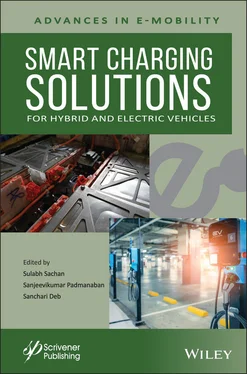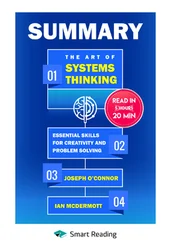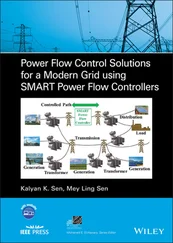Smart Charging Solutions for Hybrid and Electric Vehicles
Здесь есть возможность читать онлайн «Smart Charging Solutions for Hybrid and Electric Vehicles» — ознакомительный отрывок электронной книги совершенно бесплатно, а после прочтения отрывка купить полную версию. В некоторых случаях можно слушать аудио, скачать через торрент в формате fb2 и присутствует краткое содержание. Жанр: unrecognised, на английском языке. Описание произведения, (предисловие) а так же отзывы посетителей доступны на портале библиотеки ЛибКат.
- Название:Smart Charging Solutions for Hybrid and Electric Vehicles
- Автор:
- Жанр:
- Год:неизвестен
- ISBN:нет данных
- Рейтинг книги:4 / 5. Голосов: 1
-
Избранное:Добавить в избранное
- Отзывы:
-
Ваша оценка:
- 80
- 1
- 2
- 3
- 4
- 5
Smart Charging Solutions for Hybrid and Electric Vehicles: краткое содержание, описание и аннотация
Предлагаем к чтению аннотацию, описание, краткое содержание или предисловие (зависит от того, что написал сам автор книги «Smart Charging Solutions for Hybrid and Electric Vehicles»). Если вы не нашли необходимую информацию о книге — напишите в комментариях, мы постараемся отыскать её.
The most comprehensive and up-to-date study of smart charging solutions for hybrid and electric vehicles for engineers, scientists, students, and other professionals. Smart Charging Solutions for Hybrid and Electric Vehicles:
Smart Charging Solutions for Hybrid and Electric Vehicles — читать онлайн ознакомительный отрывок
Ниже представлен текст книги, разбитый по страницам. Система сохранения места последней прочитанной страницы, позволяет с удобством читать онлайн бесплатно книгу «Smart Charging Solutions for Hybrid and Electric Vehicles», без необходимости каждый раз заново искать на чём Вы остановились. Поставьте закладку, и сможете в любой момент перейти на страницу, на которой закончили чтение.
Интервал:
Закладка:
42. Y. Yang, Q.-S. Jia, G. Deconinck, X. Guan, Z. Qiu, and Z. Hu, “Distributed coordination of EV charging with renewable energy in a microgrid of buildings,” IEEE Transactions on Smart Grid, vol. 9, no. 6, pp. 6253-6264, 2017.
43. X. Zhu, M. Xia, and H.-D. Chiang, “Coordinated sectional droop charging control for EV aggregator enhancing frequency stability of microgrid with high penetration of renewable energy sources,” Applied Energy, vol. 210, pp. 936-943, 2018.
44. G. Barone, A. Buonomano, F. Calise, C. Forzano, and A. Palombo, “Building to vehicle to building concept toward a novel zero energy paradigm: Modelling and case studies,” Renewable and Sustainable Energy Reviews, vol. 101, pp. 625-648, 2019.
45. J. García-Villalobos, I. Zamora, J. San Martín, I. Junquera, and P. Eguía, “Delivering Energy from PEV batteries: V2G, V2B and V2H approaches.” pp. 247-15.
46. A. Tchagang, and Y. Yoo, “V2B/V2G on Energy Cost and Battery Degradation under Different Driving Scenarios, Peak Shaving, and Frequency Regulations,” World Electric Vehicle Journal, vol. 11, no. 1, pp. 14, 2020.
47. Q. Huang, X. Wang, J. Fan, S. Qi, W. Zhang, and C. Zhu, “V2G Optimal Scheduling of Multiple EV Aggregator Based on TOU Electricity Price.” pp. 1-6.
48. C. Li, Y. Cao, Y. Kuang, and B. Zhou, “Influences of EVs on Power System by Improving the Microclimate,” Influences of Electric Vehicles on Power System and Key Technologies of Vehicle-to-Grid, pp. 1-23: Springer, 2016.
49. C. Guille, and G. Gross, “A conceptual framework for the vehicle-to-grid (V2G) implementation,” Energy policy, vol. 37, no. 11, pp. 4379-4390, 2009.
50. C. Battistelli, L. Baringo, and A. Conejo, “Optimal energy management of small electric energy systems including V2G facilities and renewable energy sources,” Electric Power Systems Research, vol. 92, pp. 50-59, 2012.
51. C. Pang, P. Dutta, and M. Kezunovic, “BEVs/PHEVs as dispersed energy storage for V2B uses in the smart grid,” IEEE Transactions on smart grid, vol. 3, no. 1, pp. 473–482, 2011.
52. S. Liu, X. Xie, and L. Yang, “Analysis, Modeling and Implementation of a Switching Bi-Directional Buck-Boost Converter Based on Electric Vehicle Hybrid Energy Storage for V2G System,” IEEE Access, vol. 8, pp. 65868-65879, 2020.
53. W. Choi, Y. Wu, D. Han, J. Gorman, P. C. Palavicino, W. Lee, and B. Sarlioglu, “Reviews on grid-connected inverter, utility-scaled battery energy storage system, and vehicle-to-grid application-challenges and opportunities.” pp. 203–210.
54. K. P. Inala, P. Kumar, and S. K. Bose, “Impact of communication systems on grid node voltage and operation of a vehicle-to-grid controller in a smartgrid scenario,” IET Power Electronics, vol. 12, no. 13, pp. 3499-3509, 2019.
55. W. Han, and Y. Xiao, “Privacy preservation for V2G networks in smart grid: A survey,” Computer Communications, vol. 91, pp. 17-28, 2016.
56. C.-s. Park, E. Lee, and S.-k. Park, “Link adaptation layer of HomePlug GreenPHY for V2G communication interface.” pp. 572-573.
57. J. Lee, E. Lee, and S. Park, “Coexisting V2G PLC between G3 and HomePlug GP using dual PHY.” pp. 620-621.
58. Y. Kabalci, “A survey on smart metering and smart grid communication,” Renewable and Sustainable Energy Reviews, vol. 57, pp. 302-318, 2016.
59. K. P. Inala, B. Sah, P. Kumar, and S. K. Bose, “Impact of V2G Communication on Grid Node Voltage at Charging Station in a Smart Grid Scenario,” IEEE Systems Journal , 2020.
60. S. I.-N. Delhi, “Fame-India Scheme—Putting E-Mobility on Road,” Auto Tech Review, vol. 4, no. 5, pp. 22-27, 2015.
61. A. Harikumar, and P. Thakur, “Assessing the Impact and Cost-Effectiveness of Electric Vehicle Subsidy in India,” Journal of Resources, Energy and Development, vol. 16, no. 2, pp. 55-66, 2019.
62. S. Küfeoğlu, D. Melchiorre, and K. Kotilainen, “Understanding tariff designs and consumer behaviour to employ electric vehicles for secondary purposes in the United Kingdom,” The Electricity Journal, vol. 32, no. 6, pp. 1-6, 2019.
63. D. K. Shetty, S. Shetty, L. R. Rodrigues, N. Naik, C. B. Maddodi, N. Malarout, and N. Sooriyaperakasam, “Barriers to widespread adoption of plug-in electric vehicles in emerging Asian markets: An analysis of consumer behavioral attitudes and perceptions,” Cogent Engineering, vol. 7, no. 1, pp. 1796198, 2020.
64. F. Liao, E. Molin, H. Timmermans, and B. van Wee, “Consumer preferences for business models in electric vehicle adoption,” Transport Policy, vol. 73, pp. 12-24, 2019.
65. C. Lu, F. Chang, K. Rong, Y. Shi, and X. Yu, “Deprecated in policy, abundant in market? The frugal innovation of Chinese low-speed EV industry,” International Journal of Production Economics, vol. 225, pp. 107583, 2020.
66. O. Frendo, J. Graf, N. Gaertner, and H. Stuckenschmidt, “Data-driven smart charging for heterogeneous electric vehicle fleets,” Energy and AI, pp. 100007, 2020.
67. H. ElHusseini, C. Assi, B. Moussa, R. Attallah, and A. Ghrayeb, “Blockchain, AI and Smart Grids: The Three Musketeers to a Decentralized EV Charging Infrastructure,” IEEE Internet of Things Magazine, vol. 3, no. 2, pp. 24-29, 2020.
68. J. M. Fuller, “Social and municipal influences on electric vehicle purchases,”
2019.
69. C. Lazaroiu, and M. Roscia, “New approach for Smart Community Grid through Blockchain and smart charging infrastructure of EVs.” pp. 337-341.
70. S. Park, S. Lee, S. Park, and S. Park, “AI-based physical and virtual platform with 5-layered architecture for sustainable smart energy city development,” Sustainability, vol. 11, no. 16, pp. 4479, 2019.
71. R. Niranjan, “Digitalization for Optimization: Smart Grid operations in Finland,” 2019.
72. I. G. Unda, P. Papadopoulos, S. Skarvelis-Kazakos, L. M. Cipcigan, N. Jenkins, and E. Zabala, “Management of electric vehicle battery charging in distribution networks with multi-agent systems,” Electric Power Systems Research, vol. 110, pp. 172-179, 2014.
73. M. Liu, P. Mcnamara, R. Shorten, and S. Mcloone, “Residential electrical vehicle charging strategies: the good, the bad and the ugly,” Journal of Modern Power Systems and Clean Energy, vol. 3, no. 2, pp. 190-202, 2015.
74. A. Schuller, “Charging coordination paradigms of electric vehicles,” Plug in Electric Vehicles in Smart Grids , pp. 1-21: Springer, 2015.
75. F. Ni, L. Yan, K. Wu, M. Shi, J. Zhou, and X. Chen, “Hierarchical Optimization of Electric Vehicle System Charging Plan Based on the Scheduling Priority,” Journal of Circuits, Systems and Computers, vol. 28, no. 13, pp. 1950221, 2019.
76. D. Wu, N. Radhakrishnan, and S. Huang, “A hierarchical charging control of plug-in electric vehicles with simple flexibility model,” Applied Energy, vol. 253, pp. 113490, 2019.
77. Z. Ma, “Decentralized Charging Coordination of Large-Population PEVs Under a Hierarchical Structure,” Decentralized Charging Coordination of Large-scale Plug-in Electric Vehicles in Power Systems, pp. 109-129: Springer,
2020.
78. N. I. Nimalsiri, C. P. Mediwaththe, E. L. Ratnam, M. Shaw, D. B. Smith, and S. K. Halgamuge, “A survey of algorithms for distributed charging control of electric vehicles in smart grid,” IEEE Transactions on Intelligent Transportation Systems , 2019.
79. O. Frendo, N. Gaertner, and H. Stuckenschmidt, “Real-time smart charging based on precomputed schedules,” IEEE Transactions on Smart Grid, vol. 10, no. 6, pp. 6921-6932, 2019.
Читать дальшеИнтервал:
Закладка:
Похожие книги на «Smart Charging Solutions for Hybrid and Electric Vehicles»
Представляем Вашему вниманию похожие книги на «Smart Charging Solutions for Hybrid and Electric Vehicles» списком для выбора. Мы отобрали схожую по названию и смыслу литературу в надежде предоставить читателям больше вариантов отыскать новые, интересные, ещё непрочитанные произведения.
Обсуждение, отзывы о книге «Smart Charging Solutions for Hybrid and Electric Vehicles» и просто собственные мнения читателей. Оставьте ваши комментарии, напишите, что Вы думаете о произведении, его смысле или главных героях. Укажите что конкретно понравилось, а что нет, и почему Вы так считаете.












